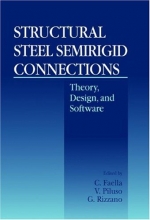Tab Article
Provides a state-of-the-art summary of the most recent experimental and theoretical developments on the behavior and design of semirigid connections
Offers design criteria for both braced and unbraced frames
Presents comparisons of US and European design practices
Includes software on floppy disk for predicting the moment-rotation curve of beam-to-column joints, with a user guide and sample problems provided in the text
Although the semirigidity concept was introduced many years ago, steel structures are usually designed by assuming that beam-to-column joints are either pinned or rigid. Theses assumptions allow a great simplification in structural analysis and design-but they neglect the true behavior of joints.
The economic and structural benefits of semirigid joints are well known and much has been written about their use in braced frames. However, they are seldom used by designers, because most semirigid connections have highly nonlinear behavior, so that the analysis and design of frames using them is difficult. In fact, the design problem becomes more difficult as soon as the true rotational behavior of beam-to-column joints is accounted for-the design problem requires many attempts to achieve a safe and economical solution.
Structural Steel Semirigid Connections provides a comprehensive source of information on the design of semirigid frames, up to the complete detailing of beam-to-column connections, and focuses on the prediction of the moment-rotation curve of connections. This is the first work that contains procedures for predicting the connection plastic rotation supply-necessary for performing the local ductility control in nonlinear static and dynamic analyses. Extensive numerical examples clarify the practical application of the theoretical background.
This exhaustive reference and the awareness it provides of the influence of joint rotational behavior on the elastic and inelastic responses of structures will greatly benefit researchers, professionals, and specification writing bodies devoted to structural steel.


